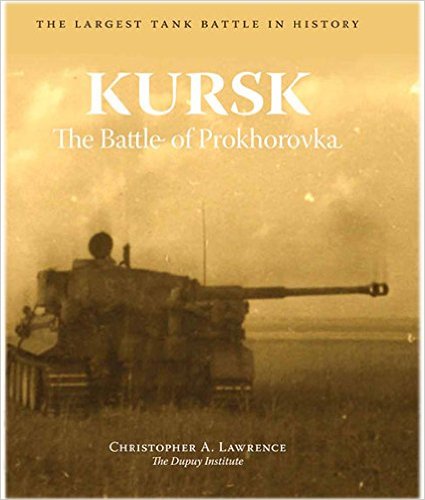[This post was originally published on 3 April 2017.]
Displayed across the top of my book is the phrase “Largest Tank Battle in History.” Apparently some people dispute that.

What they put forth as the largest tank battle in history is the Battle of Brody in 23-30 June 1941. This battle occurred right at the start of the German invasion of the Soviet Union and consisted of two German corps attacking five Soviet corps in what is now Ukraine. This rather confused affair pitted between 750 to 1,000 German tanks against 3,500 to 5,000 Soviet tanks. Only 3,000 Soviet tanks made it to the battlefield according to Glantz (see video at 16:00). The German won with losses of around a 100 to 200 tanks. Sources vary on this, and I have not taken the time to sort this out (so many battles, so little time). So, total tanks involved are from 3,750 to up to 6,000, with the lower figure appearing to be more correct.
Now, is this really a larger tank battle than the Battle of Kursk? My book covers only the southern part of the German attack that started on 4 July and ended 17 July. This offensive involved five German corps (including three Panzer corps consisting of nine panzer and panzer grenadier divisions) and they faced seven Soviet Armies (including two tank armies and a total of ten tank and mechanized corps).
My tank counts for the southern attack staring 4 July 1943 was 1,707 German tanks (1,709 depending if you count the two Panthers that caught fire on the move up there). The Soviets at 4 July in the all formations that would eventually get involved has 2,775 tanks with 1,664 tanks in the Voronezh Front at the start of the battle. Our count of total committed tanks is slightly higher, 1,749 German and 2,978 Soviet. This includes tanks that were added during the two weeks of battle and mysterious adjustments to strength figures that we cannot otherwise explain. This is 4,482 or 4,727 tanks. So depending on which Battle of Brody figures being used, and whether all the Soviet tanks were indeed ready-for-action and committed to the battle, then the Battle of Brody might be larger than the attack in the southern part of the Kursk salient. On the other hand, it probably is not.
But, this was just one part of the Battle of Kursk. To the north was the German attack from the Orel salient that was about two-thirds the size of the attack in the south. It consisted of the Ninth Army with five corps and six German panzer divisions. This offensive fizzled at the Battle of Ponyiri on 12 July.

The third part to the Battle of Kursk began on 12 July the Western and Bryansk Fronts launched an offensive on the north side of the Orel salient. A Soviet Front is equivalent to an army group and this attack initially consisted of five armies and included four Soviet tank corps. This was a major attack that added additional forces as it developed and went on until 23 August.
The final part of the Battle of Kursk was the counter-offensive in the south by Voronezh, Southwestern and Steppe Fronts that started on 3 August, took Kharkov and continued until 23 August. The Soviet forces involved here were larger than the forces involved in the original defensive effort, with the Voronezh Front now consisting of eight armies, the Steppe Front consisting of three armies, and there being one army contributed by the Southwestern Front to this attack.

The losses in these battles were certainly more significant for the Germans than at the Battle of Brody. For example, in the southern offensive by our count the Germans lost 1,536 tanks destroyed, damaged or broken down. The Soviets lost 2,471 tanks destroyed, damaged or broken down. This compares to 100-200 German tanks lost at Brody and the Soviet tank losses are even more nebulous, but the figure of 2,648 has been thrown out there.
So, total tanks involved in the German offensive in the south were 4,482 or 4,727 and this was just one of four parts of the Battle of Kursk. Losses were higher than for Brody (and much higher for the Germans). Obviously, the Battle of Kursk was a larger tank battle than the Battle of Brody.
What some people are comparing the Battle of Brody to is the Battle of Prokhorovka. This was a one- to five-day event during the German offensive in the south that included the German SS Panzer Corps and in some people’s reckoning, all of the III Panzer Corps and the 11th Panzer Division from the XLVIII Panzer Corps. So, the Battle of Brody may well be a larger tank battle than the Battle of Prokhorovka, but it was not a larger tank battle than the Battle of Kursk. I guess it depends all in how you define the battles.
Some links on Battle of Brody:
https://en.wikipedia.org/wiki/Battle_of_Brody_(1941)
http://warisboring.com/the-biggest-tank-battle-in-history-wasnt-at-kursk/

Well, If I recall correctly the argument for Dubno is simply that while Kursk saw a higher accumulation of total AFVs, in 41 there was a higher number of tanks in direct engagmenets, confined to a smaller area, while the contigencies around Prokhorovka can be understood more like “plier” movements, happening here and there, if that makes any sense.
On a side note: I do have a question regarding the Swedish War College. I composed a very long E-Mail, contact information is scarce, it seems to be impossible to reach Dr. Zetterling (he recently published his new book), is there any contact information or just some way that this Mail could reach him? If I recall correctly TDI had always good relations to Mr. Z.
I am still in contact with Dr. Zetterling. Send me an email and I will forward it to him.
Much appreciated. I used contact@dupuyinstitute, thats the only address I know of.
That works.